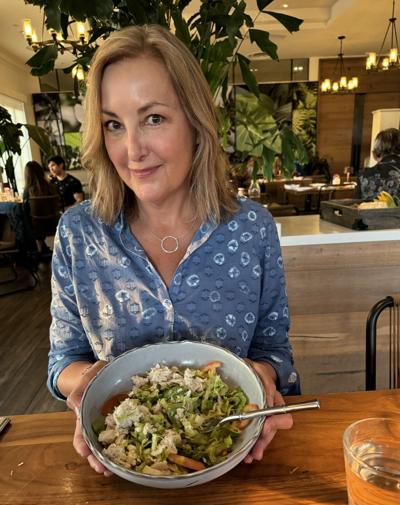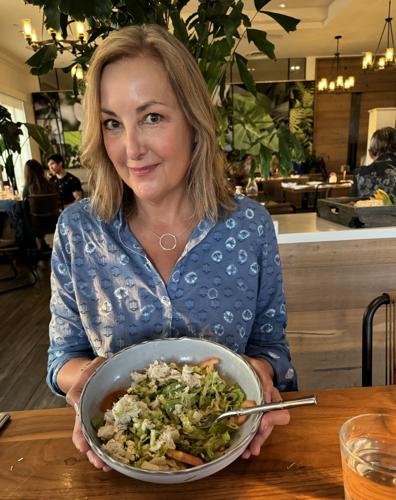One of the less desirable consequences of getting older is not being able to eat as much as we used to without packing on the pounds. Something happens in those decades post-30s or 40s that necessitates cutting back on favorite foods or paying the price of a pudgier waistline.
It’s normal to want to keep the weight off for reasons having to do with appearance and the practicality of fitting into our clothes, but there are medical benefits as well. Maintaining a healthy weight is easier on the joints, helps manage cholesterol and blood pressure, and can stave off type 2 diabetes. All good reasons to do whatever we can to avoid the weight creep that comes with aging.
I don’t expect to weigh the same as I did in my 20s, 30s or even 40s now that I’m 60. I was always on the thin side, and I’m OK with being less svelte as long as my BMI is in a healthy range. And with the exception of those enviable outliers who seem to stay forever slim, most of us eventually battle some age-related poundage.
Fortunately, there are ways to prevent weight creep, and some people even become thinner and healthier than they were in their younger days. But it’s so much easier said than done.
I’ve had the “I can’t seem to lose weight no matter what I do” discussion with many similar-aged friends over the years. Here are some anecdotes, tips and even a few laughs shared while discussing the woes of managing weight in middle-age and beyond.
1. Follow a specific eating plan.
My 78-year-old neighbor adheres to a strict Mediterranean/vegetarian diet, which has kept her healthy and slim. If she gains a few pounds, she’s disciplined enough to take it off pretty quickly. She also walks between 4-5 miles a day.
Others swear by Keto, Paleo, Atkins, going carb- or gluten-free, or any number of variations with emphasis on more protein, healthy fats and veggies and less carbs. I won’t go into detail since all of these diets/eating plans can be found on the internet.
2. “I eat less than ever, exercise more and weigh more … what gives?”
Ah, the dreaded slowing metabolism. I sometimes pretend that I can eat like I did 30 years ago without paying the price of a snug waistband.
I wistfully remember how easy it was to lose a few pounds by skipping a meal. Being young means not understanding the heartbreak of back fat or bat wings.
3. Just don’t eat anything for 16 hours and you’ll be good!
Many people swear by intermittent fasting — where you limit your eating window to eight hours or less and fast the rest of the time. This doesn’t work for people like me who wake up ravenous and have a tendency toward low blood sugar.
I envy those who can skip breakfast and be productive until lunch hour. I even dread when a fasting lab is required. I scramble for the earliest appointment and bring a snack with me in the car — a snack I immediately scarf down once the lab work is complete.
4. Those helpful menus that ruin an otherwise delightful meal.
While perusing the menu during a lunch with friends, we noticed an offering of “OMG Grilled Cheese!” The description was tempting — a gourmet grilled cheese sandwich with bacon and other decadent condiments, served aside a cup of tomato basil soup.
The kicker: They also included the calorie count — a whopping 1,100 for what seemed like an innocent throwback to mom’s soup and sandwich. What to do? In this instance, my friends thew caution to the wind and ordered the “OMG Grilled Cheese.” YOLO, right?
I’ve noticed that more restaurants are following this trend. This is certainly helpful, while also being somewhat depressing. Who knew that a seemingly healthy salad could have upwards of 1,500 calories? I mean, I expect that from a giant baked good, but a salad?
5. Calories, portions and not cleaning your plate.
The old “calories in vs. calories out” is tried and true, but slow and steady wins the race with this method. There’s also portion control, leaving half of the meal on the plate or sharing an entrée. Taking home leftovers instead of stuffing it all in at one meal. Balancing a bigger meal with a smaller meal later in the day. Eating a large lunch and just nibbling for dinner. It’s all in the math.
6. Restrict, then enjoy.
A few readers said they eat healthier on weekdays — focusing on protein, fruits and vegetables — and then indulge a bit more on the weekend. This is a great way to avoid feeling deprived and allows for more leeway when dining out or celebrating a special occasion. It’s hard to turn down that wedding cake!
7. Deny the sweet tooth?
Giving up sugar seems to be a recipe for successful weight management along with other health benefits, but it’s sooo hard to do.
I commiserate with my fellow sweet-toothers. As with many food choices, moderation seems to be key. Splitting a dessert four ways lessens the guilt and subsequent calorie splurge. How bad can just a few bites of chocolate lava cake be anyway?
8. To drink, or not so much?
Several readers mentioned that they can’t tolerate alcohol like they did in the past, touting sleep disturbances, headaches or other symptoms. Others look forward to daily 4 p.m. happy hours.
Alcohol does add empty calories — which often translates to belly fat. I know people who’ve given up alcohol for Lent or dry January and ended up shedding 10 pounds or more. Food (or drink) for thought.
9. Methods for achieving and maintaining a healthy weight as we age vary.
There is no “one size fits all” solution for weight loss or maintenance. What works for some won’t work for all. Common-sense strategies including portion control; cutting down on sugar, alcohol and carbs; eating more protein, fruits and vegetables; and exercising regularly are a good foundation.
Unfortunately, we can’t slow down father time. Our bodies and metabolism change as the years roll by. That’s something we all need to accept. It’s extremely difficult to live up to an unrealistic standard of having the body we had when we were 30 during our 50s, 60s, 70s and beyond.
The key is to do the best we can to maintain a healthy weight for our current age. One that that enables an active lifestyle well into our later years.
That may or may not include fitting into our skinny jeans. But then, that’s not really the goal, is it?
Here’s to eating (mostly) healthy at every age.













